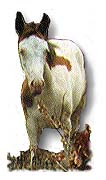
GREAT ABACO, BAHAMAS... Once, they were a mighty herd, perhaps 200 strong: pinto, bay and roan horses rippling through thousands of acres of pine forest. They were as free as the sea winds that blew across the island they had conquered.
Their origins remained unclear until 1998. It was thought that some of their ancestors came from domestic animals brought by English Loyalists who abandoned North America during the American Revolution. When some of the colonizing attempts failed, the horses were turned loose and left behind.
Others were thought to have come with the
logging operations that cleared Wilson city in the south of Great Abaco
and Norman's Castle in the north. And these logging horses may have come
from Cuba. When the logging company clear-cut itself into oblivion, the
horses were abandoned.
In 1998 it was discovered that the horses probably are Spanish Barbs.
Pending DNA testing, it is 99% certain that they are genetically pure
- having been 'untampered' with for over 250 years.
 |
Few horse wise people
would have expected those domesticated horses to survive in this place.
Whether you come by air or by sea, this does not look like horse country After years of being fed, groomed and cared for, suddenly the gates were open. The halters were gone. The mangers were empty. After a sea voyage that could have lasted six weeks or more, with little food or water to reduce manure they either were wrecked or abandoned on this island. |
| The horses stood for a
while, blinking in the sun. It grew hotter and hotter as the sun rose. Slowly, they moved off seeking shelter, food, and in the manner of horses, companionship |
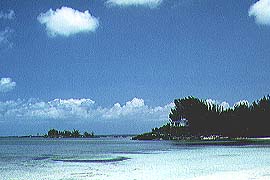 |
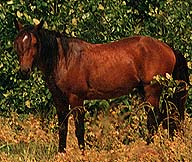 |
And survive the horses did, as they had been bred to do under appalling conditions. In fact, they flourished flourished. They came from sturdy stock, with compact bodies and strong legs. |
| Long tails and flowing manes and gleaming coats made them beautiful. | 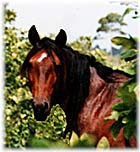 |
 |
Abandoned on a sun-drenched and salt-seared island, they found shelter in pine forests |
 |
The pine forests of Abaco are something few visitors know exist. In the Bahamas, the Caribbean pines (Pinus caribaea), exist only on Grand Bahama, Andros, Abaco and New Providence Islands. On Abaco, the forests provided a home for the tough, romantic and equally rare wild Spanish Barb horses. |
| In the dappled shade of the pines the horses escaped the burning sun. They tramped out a network of pathways among the grazing places and the sloughs and springs where they watered. | 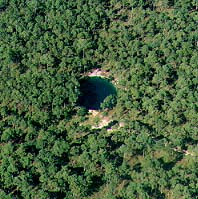 |
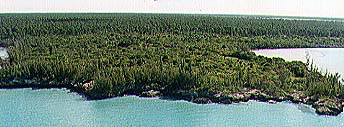
The pine forests had for millennia sheltered flocks of wild parrots and migrating birds. Scores of species of orchids, other plants and thousands of insects lived in the forest.
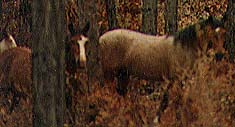 |
The forests sheltered the wildhogs, also abandoned by the early settlers, and they sheltered the horses. |
| In addition to shelter,
the forests provided food. After fires set by lightning bolts swept
away the underbrush, fresh grasses sprang up and provided a change
of diet from the grasses that grew in open areas. The nourishing grasses probably had arrived as seeds in the crops of migrating birds. |
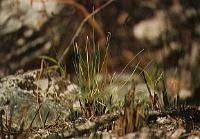 |
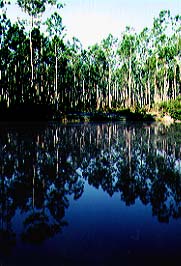 |
Even in the worst droughts
the horses had water. They had enough room to roam and graze, and they grew sleek. Only an occasional horse was lost to people from the outer islands who captured a few for work at sugar cane mills. |
| Then, in the 1960's, disaster
struck. Neither a hurricane, nor a catastrophic drought nor a tidal
wave. No impossible fire, flood or disease. A road. A simple road
was carved out of the chalky limestone surface of Great Abaco. A road
running from one end of the island to the other so that Owens-Illinois
could harvest the remaining forests for pulpwood. The shelter of the pines was shattered. Suddenly humans had access to miles and miles of long-abandoned but still passable logging roads from earlier operations. |
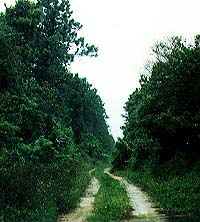 |
Boar hunters, who once had to walk in after their prey, now could drive pick-up trucks full of dogs, men and guns right into new territory.
Once they had to carry out one heavy animal on their shoulders. Now they could slaughter and carry six or seven.
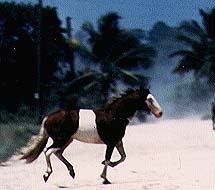 |
The hunters could also
run the horses down these narrow roads until they were close enough
to be roped out of the windows or until they dropped from exhaustion. Many of these animals became legends, for their anecdotal lives, the vicious cruelty visited on them, and their tragic ends. Often, the hunters' dogs would chase the horses instead of the boars and just as often the horses would trample the dogs in self defense. The hunters began to shoot the horses. But few people other than the hunters knew about this at the time. |
"There aren't any more
wild horses on Abaco."
"The horses have all been killed."
"The horses have all died of pesticide poisoning"
"I've been going to Abaco for 20 years and I never heard of any horses."
"There were horses once but they've all been shot."
"There were horses here, but when the big road went in some man tried
to capture one by throwing a spear at it. It died."
"They all died."
These were some of the things I was told before I sailed to Abaco in April
of 1992.
And I heard more of the same after I arrived at Green Turtle Cay...
| The quest had begun with
two sentences buried on page 235 of the 1992 "Yachtsman's
Guide to the Bahamas:""The old settlement of Norman's
Castle...in days gone by...was a busy logging camp, but it was abandoned
in 1929. Today few traces of the settlement or the industry remain
and the only inhabitants are herds of wild horses..." As a horse crazy child I read every romantic horse novel ever printed and most of them contained that mystical, irresistible combination of plucky youngsters, mysterious islands and horses in need of rescue. |
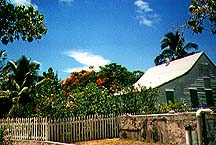 |
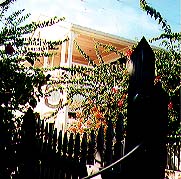 |
When I later transferred
that equine passion into one for old wooden sailboats, I still had
horses galloping around in my heart. And my heart nearly stopped when,
while planning the sailing trip to Abaco, I read those two short sentences. The only positive information I got was from the editor of the guide who said she knew they were there, and from Gary Larson of the Bahamas National Trust who said "Yes, they are there." |
| I headed for Green Turtle Cay which lies about two miles north of the area where I hoped the horses would be. Day after day I poked around the town of New Plymouth pestering everyone about the horses. A week went by with no clues, yet it was too soon to think about quitting. It seemed odd, though. I was used to instantaneous communication. There was the big island, just two miles away, and no one knew anything about its wild inhabitants. | 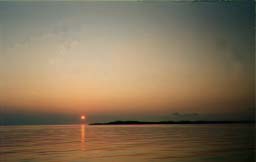 |
Finally, about eight days after I had arrived, I heard that Stephanie Roberts, whose parents own Roberts Hardware in New Plymouth, had not only seen the horses but had taken some photos of them during a trip to Great Abaco in 1991. They were on a citrus farm in the Norman Castle area. I was given the name of the farm manager, and through yet another stroke of luck my very first call connected my to Lynn Key whose husband Henry was the Manager of Bahamas Star Farms.
The Keys graciously invited me for a visit and a few days later I was on the Green Turtle Ferry heading for a smokey green swath on the horizon where there might be wild horses.
| Lynn and Henry met me
at the dock. Lynn and I rode in the back of a pick-up hanging on to
cameras heavy with telephoto lenses. With our free hands we clung
to the truck cab as we bounced over miles and miles of packed dirt
roads. When we spotted our first far off group I had to fight back tears as I fussed with the manual focus on the camera. The horses were real. After months of preparation, weeks of travel and days of negative response, there there they were. Not ponies, not scruffy, shaggy little drudges, but big, healthy bright-coated horses. |
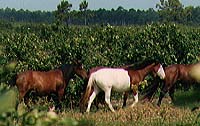 |
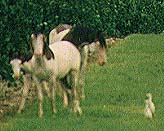 |
Each time we spotted a
group we'd thump on the roof of the cab and Henry, with his knowledge
of every bump and ridge, would get us as close as possible While we took photos Henry kept up with business via two-way radio and cellular phone and he still spotted groups Lynn and I had missed. |
| The horses were cautious but not spooky. If we tried to approach on foot they simply turned and walked away. Or managed to hide in very small places. There are two horses hiding in this photo. Can you find them? | 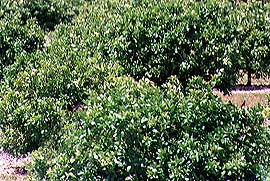 |
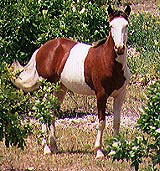 |
One of the groups had a special treat for us, a beautiful yearling stallion who was the image of one of the foals Stephanie Roberts had photographed the year before. |
| Here he was, growing well and just full of sass and spirit. He has been named Antares and his mother is Bellatrix. Bellatrix has a pink face from sunburn. | 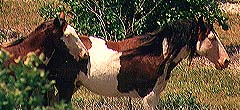 |

How had the wild horses, slaughtered to the point of extinction in the 1960's,come to be alive at all, let alone in a healthy, energetic herd of about 30 head which roams the farm and nearby regenerating forest?
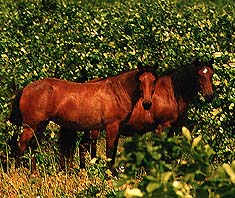 |
No one is quite sure exactly how the decision was made to bring the wild horses back. Certainly, Edison Key, Floyd Sawyer, Gayle Cottman and Steve Albury all had a part in the seemingly casual events that saved the wild horses of Abaco. |
Edison Key and his brother-in-law Morton Sawyer were the partners developing the farm. They provided the place, the approval and the manpower, probably the original idea. Steven Albury was a young man working on the farm in the early 1970's. Morton Sawyer's son Floyd already had two wild hroses at the farm. The mares were named Liz and Jingo. Jingo may have been Liz's foal. And Jingo probably was named after the horse in the classic childrens' story Jingo, Wild Horse of the Abacos, illustrated by Wesley Dennis.
| Senator Edison Key, Henry's
father, gave his version: "When we were clearing the land for
the farm project in the early 1970's, we found carcasses and bones
all over. "We were starting a cattle ranching effort. The Bahamas could have been self-sufficient in beef production. We put about 400 acres into deep-rooted grasses, high protein legumes that could get to the water. We built a corral, drove posts, strung fences and then imported 200 head of steer from the Dominican republic." (Ed.Note: The cattle raising effort ended when Owens-Illinois left.) |
 |
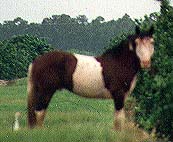 |
Steve said there was no
big premeditation, but at some point he and a man remembered only
as 'Gunn,' who had come over with the cattle imported from the Dominican
Republic, and who was 'supposed to know something about horses,' went
down to Marsh Harbour and brought back a stallion named Castle. Gayle
Cottman had been taking care of Castle. And every pinto in today's growing herd bears his unmistakeable stamp. |
| According to Gayle Cottman,
"They all look just like Castle." She was delighted when
she saw the first photos. Castle died a natural death around 1989,
probably close to 30 years old. |
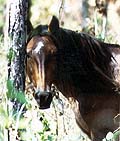 |
The bays in the herd are from Liz and Jingo and some of them bear the delicate features that Dennis gave Jingo in his book.
| Those three horses simply lucked out. According to Effie Schneider, Edison Key's sister, the horses shared buidlings, shelter, feed, grass and grain with the cattle. When a vet came to check the cattle, he checked the horses. | 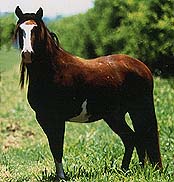 |
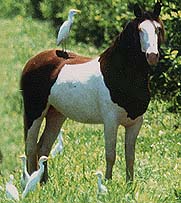 |
One farm hand was assigned to the horses full time until they became acclimated and were released. Today's horses, descended from the last stallion of the original wild herd, returned to the pine forests. The herd is growing slowly in spite of wild dog attacks which kill several foals a year. |
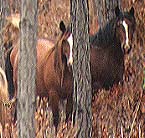 |
The farm now covers 3000
acres and the grasses imported for the cattle have spread. In the
savannah-like areas of the farm -- planted in limes, grapefruits and
oranges -- are acres and acres of forage the horses relish. Henry Key says the soil is exceptional. It is red and clay-ey and holds moisture well. The biggest pines grew here. |
| In 1992, the future seemed bright. Henry Key said simply, "We were brought up to not kill things." |  |
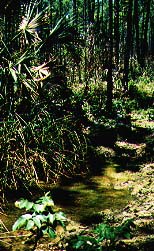 |
By 1997 the herd had dropped
from over 30 to 16. Individuals I had identified and knew by sight
had vanished. corpses and skeletons were turning up in alarming numbers. As usual, it is human pressure that causes concern and it is the goal of the Abaco Wild Horse Fund to try to remove that pressure. by 1998 with the survival of four fillies, the herd was up to 21. It is hoped that this is a trend, and not a glitch . And the horses, to be truly wild, need the forest. They survived before without the farm. The forest shelters the horses from the sun. The limey outcroppings keep their hooves pared down and naturally trimmed. |
After a burn, the forest floor is covered with succulent new grasses for forage. If the horses are to remain wild, some of the forest must remain wild too.
The AWHF, working in conjunction with the Boy and Girl Scouts of Abaco, hopes to have the forest surrounding the farm declared a preserve.
 |
Wildfire is a critical
part of the wild forest cycle. But too many (90%, according to one source)of these fires are started by man to clear landfor cultivation and to drive hogs from the dense brush. Although often severely charred, adult pines are seldom killed by flames. |
| The younger pines are
less fortunate, though reseeding takes place quickly aorund the bottoms
of the adult trees whose pine cones are burst open by the heat, thus
releasing the seeds. But constant, deliberate burning will upset the forest cycle. New pine growth will burn with the brush and the juveniles will never get a chance to mature. Orchids and wildflowers die out. |
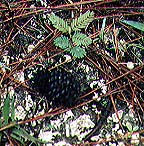 |
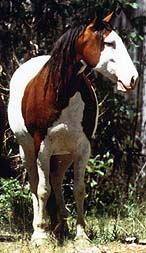 |
The saga of the wild horses
and their home in the pines teaches several important lessons. Left
to their own devices, things tend to seek a natural balance. Over-hunting,
over-cutting, over-burning all upset this natural order and the inevitable
result is too much dying. The inevitable result of too much dying
is extinction .Many people feel that the horses' survival may point the way to a better future in Abaco. Henry Key looks toward this future when he says "We need to publicize the concept of wild things being able to peacefully interact with formal land use." |
|
Article and photos courtesy of Milanne Rehor and the Abaco Wild Horse Fund.
